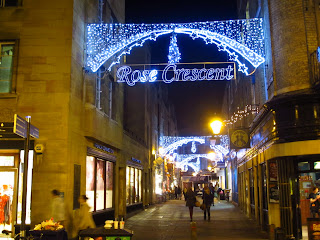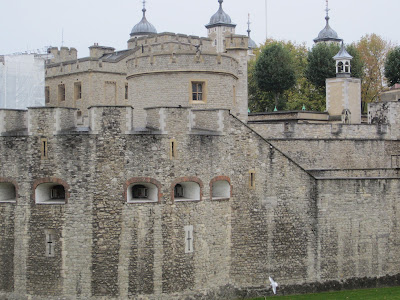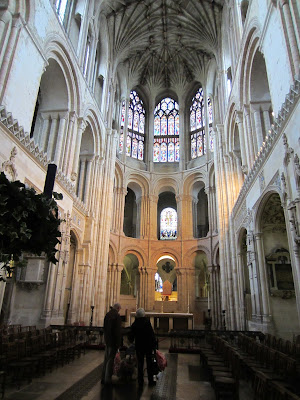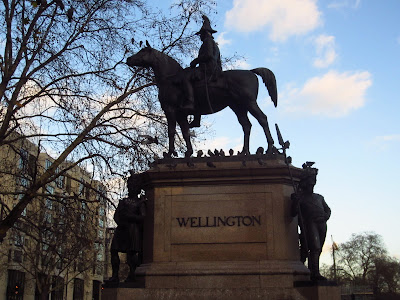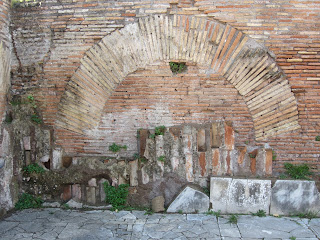 |
| Borghese Gallery |
Our last full day of touring was as busy as all the others had been. We took cabs to the Borghese Gallery in the northern part of the city. Visitors are strictly limited to a two hour visit. While we waited to enter, we learned about Cardinal Borghese, nephew of Pope Paul V and collector of these art works, and how easy it is for the powerful to acquire what they want (what else is new?). Once inside we focused on paintings by Caravaggio (his painting of Mary, Jesus, and Ann was thought to be blasphemous when it was first shown) and sculptures by Bernini who had a flair for the flamboyant even during the strict era of the Counter Reformation. We saw his works of Aeneas fleeing Troy, the Rape of Proserpine, and Apollo and Daphne. Not knowing all the ancient myths and legends, we would have been lost without the insights of our guide. Grazie! Once again the only pictures that were allowed were ones outside the gallery.
 |
| The only part of the Borghese gardens we could see |
The Pines of Rome--source of those expensive pine nuts
From the Borghese Gallery we walked to the Church of the Santissima Trinita del Monti, better known as the church in front of the Spanish Steps. This area is great for people watching which is what we did. At the base of the steps is a fountain called the Sinking Boat which was built by one of the Berninis and is powered by an aqueduct.
 |
| The obelisk in front of the church is a fake--misspelled hieroglyphics |
 |
| Spanish Steps |
 |
| A good place to munch an apple |
Over time, Rome decreased in size from about 1,000,000 to 20,000 inhabitants.
 |
| Sinking Boat |
Back when the barbarians were attacking Rome, they destroyed the aqueducts, thus cutting off Rome's supply of fresh water. Romans were forced to use the polluted river as their source of
water and many died from disease.
During our free afternoon we had a delicious and inexpensive lunch of pasta followed by some strawberry gelato. We needed energy to climb the steps of the Victor Emmanuel Monument at the Piazza Venezia! We had been seeing this white memorial all week long from many vantage points and decided we needed to visit it and see its reputed great views of the city.
The Victor Emmanuel Memorial boasts the largest equestrian statue in the world.
Tomb of the Unknown Soldier
Tom and Victor Emmanuel who fought for the unification of Italy
Looking south: views of the Colosseum, another domed church, and the Forum
We celebrated the conclusion of our Rome tour with a last group dinner. Once again the food was fantastic especially the many antipasto offerings: prosciutto, olives, mozzarella, zucchini, and my favorite—fresh anchovies. After the antipasto and many bottles of wine, came saltimbocca and then tiramisu, coffee, and limoncello for the final course. What a feast! Good thing we had one last evening stroll. And, yes, we did add our names to the wall of satisfied patrons.
Similar to our evening walk to the Pantheon, the approach to the Trevi Fountain was almost magical.
As we walked down narrow streets we could hear the fountain but couldn’t see it until we turned the last corner.
Like all the other tourists there (it was packed!) we made a wish, took aim and and tossed a coin over our left shoulder into the fountain.
 |
| Trevi Fountain |
Arrivederci Roma!!!!!!!!!!!
~~~~~~~~~~~~~~~~~~~~~~~~~~~~~~~~~~~~~~~~~~~~~~~~~~~~~~~~~~~~~~~~~~~~~~~~~
**********************************************************************************
~~~~~~~~~~~~~~~~~~~~~~~~~~~~~~~~~~~~~~~~~~~~~~~~~~~~~~~~~~~~~~~~~~~~~~~~~
Our group at Ostia Antica with our guide Ben on the right.
After a week of our own Roman Holiday visiting various monuments, churches, and ruins with riches intact or looted, we are left with burning questions:
Is there any marble left on this earth to be excavated???
AND
Why are all the toilet seats in Rome missing???




